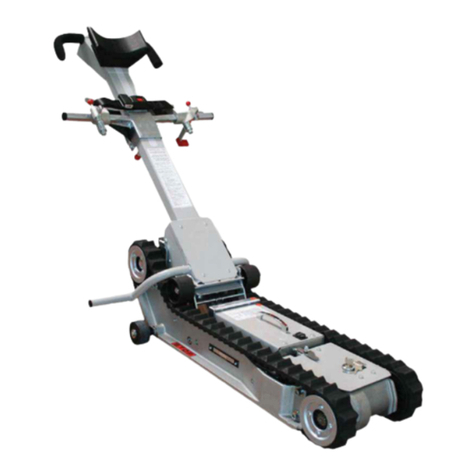Please write the serial number and date purchased in the following blank space.
Serial number
Date of Purchase Year MonthDay
•Type, Serial number QJ SA-3 •
Powered stair climber, STAIR AID SA-3
SAFETY PRECAUTIONS
To maintain safe operation, important safety precautions, classified into
Danger, Warning
and
Caution
, are
indicated in corresponding parts of me operation manual. The definition of each precaution is explained in the
following section.
DANGER
WARNING
CAUTION
Neglecting this warning indication or operating the machine improperly may
cause serious personal injury or even death.
CE-marking With the CE marking the manufacturer declares compliance with the
essential requirements of Directive 93/42 / EEC
Neglecting this warning indication or operating the machine improperly may
seriously endanger the concerned person‘s health or life.
Neglecting this warning indication or operating the machine improperly may
cause injury to the concerned person or damage the machine or related items.
If you transfer this machine, be sure to attach this operation manual to the machine.
2
C
M
Y
CM
MY
CY
CMY
K
2014_SA3.pdf 1 06.07.15 17:51
C
M
Y
CM
MY
CY
CMY
K
2014_SA3.pdf 1 22.04.16 10:15
INTRODUCTION
Thank you for purchasing STAIR AID, BARTELS POWERED STAIR CLIMBER. This manual describes proper operating
procedure, inspection and maintenance. The user manual is a useful help for operator and passenger.
Before running the machine, be sure to read this manual thoroughly. Please keep this manual in the same, easily
accessible place. Ensure that the STAIR AID SA-3 is operated by properly skilled and experienced person only! Never
leave stair climber and passengers – except in emergency cases – alone on stairs.
All machines are referred to by their serial numbers. Whenever you inquire about a machine, be sure to inform us of its
serial number.
The serial number is inscribed on the side of the machine. Please record its number and year, month and date of purchase
in the operation manual.
•
The STAIRMATE is a medical device class I and satisfies the requirements of ISO 7176-28.
•
The STAIRMATE is a motorized stair-lift for in wheelchairs seated persons who are not able to overcome stairs
on their own and thus it is associated with type B (ISO 7176-28: 2012 Annex A). The product is used exclusively
to overcome stairs and has no driving mode for flat surfaces.
•
STAIR AID is designed to carry one passenger.
Never carry a baby in the arms, have a child on the passenger‘s lap or carry any similar load while using STAIR AID
even when the total weight does not exceed STAIR AID‘s maximum load. Unprescribed usage is dangerous.
Only one passenger can use STAIR AID while Seat Belt is fastened.
•
The operator must call out to the passenger to inform him/her the next action with simple words in order to reduce
passenger‘s anxiety before the operator moves STAIR AID to the next phase of the procedure. (Pay special attention
to reducing passenger anxiety before and during STAIR AID‘s ascent/descent of the stairs.)
•
The stability tests have been performed with dummies. Standard wheelchairs were used.
•
The results of the stability tests may vary in real situations.
INHALT
MINIMALEMINIMUM LANDING SPACE ............................................................................................................................. 4
NOTES ................................................................................................................................................................................ 5
1. ESSENTIALS OF SAFE OPERATION ........................................................................................................................... 6
1.1. PURPOSE OF USE...................................................................................................................................................... 6
1.2. ADVICE - STAIRS ........................................................................................................................................................ 6
1.3. INSPECTION................................................................................................................................................................ 6
1.4. HANDLING OF THE BATTERY.................................................................................................................................... 7
1.5. SAFE OPERATION THROUGH PERFECT KNOWLEDGE......................................................................................... 7
1.6. USAGE ON STAIRS..................................................................................................................................................... 7
1.7. STOPPING DEVICE..................................................................................................................................................... 7
1.8. SURFACE FINISH........................................................................................................................................................ 7
2. CONFIGURATION AND SPECIFICATIONS................................................................................................................... 8
2.1. PRODUCT CONFIGURATION..................................................................................................................................... 8
2.2. SPECIFICATIONS........................................................................................................................................................ 8
2.3. MATERIALS USED ...................................................................................................................................................... 9
2.4. OPERATING AND STORAGE CONDITIONS .............................................................................................................. 9
2.5. CONTRAINDICATIONS ............................................................................................................................................... 9
2.6. ELECTROMAGNETIC RADIATION ............................................................................................................................. 9
2.7. DEVICE IDENTIFICATION........................................................................................................................................... 9
3. NAME OF EACH UNIT ................................................................................................................................................... 9
4. ASSEMBLING THE MACHINE..................................................................................................................................... 10
4.1. NAME OF EACH ASSEMBLY .................................................................................................................................... 10
4.2. TRANSPORT ............................................................................................................................................................. 10
4.3. ASSEMBLY PROCEDURE......................................................................................................................................... 10
4.4. HEADREST AND BACK PAD ATTACHMENT............................................................................................................ 12
5. DESCRIPTION OF EACH UNIT ................................................................................................................................... 13
5.1. SWITCHES................................................................................................................................................................. 13
5.2. BATTERY PACK REMOVAL AND REINSTALLATION ............................................................................................... 14
5.3. EMERGENCY BATTERY PACK REMOVAL AND REINSTALLATION ....................................................................... 15
5.4. CIRCUIT BREAKER RESETTING PROCEDURE ..................................................................................................... 16
5.5. STAIR GAUGE HANDLING PROCEDURE................................................................................................................ 17
6. BATTERY CHARGE SYSTEM...................................................................................................................................... 18
6.1. BATTERY ................................................................................................................................................................... 18
6.2. CHARGER.................................................................................................................................................................. 18
6.3. CHARGING PROCEDURE ....................................................................................................................................... 19
6.4. MALFUNCTION, INSPECTION, RESOLUTION PROCEDURE ................................................................................ 21
6.5. BATTERY REPLACEMENT ....................................................................................................................................... 22
6.6. HANDLING WARNING OF LEAD BATTERY ............................................................................................................. 23
7. PRE-USE INSPECTION................................................................................................................................................ 24
8. OPERATION ................................................................................................................................................................. 28
8.1. WHEELCHAIR SETTING ........................................................................................................................................... 28
8.2. ASCENDING STAIRS................................................................................................................................................. 33
8.3. DESCENDING STAIRS.............................................................................................................................................. 36
9. DAILY MAINTENANCE AND CARE............................................................................................................................. 38
9.1. BATTERY ................................................................................................................................................................... 38
9.2. RUBBER CRAWLERS ............................................................................................................................................... 38
9.3. STORAGE OF STAIR AID ......................................................................................................................................... 38
9.4. CLEANING AND DESINFECTION............................................................................................................................. 38
10. TERMS OF GUARANTEE .......................................................................................................................................... 38
11. MAINTENANCE / REPAIR .......................................................................................................................................... 38
12. RE-USAGE.................................................................................................................................................................. 38
13. INSPECTION BY THE OPERATOR ........................................................................................................................... 39
14. LIFETIME .................................................................................................................................................................... 40
15. DISPOSAL .................................................................................................................................................................. 40
NOTES .............................................................................................................................................................................. 41
16. AGENTS ABROAD ..................................................................................................................................................... 42
3




























